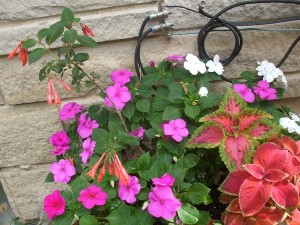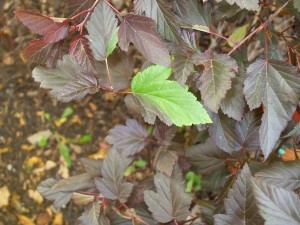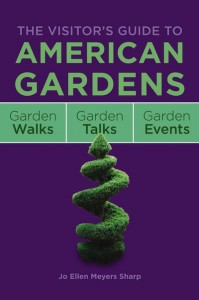
Disanthus' red leaves compliment the large blue leaf hostas at the Indianapolis Museum of Art. (C) Jo Ellen Meyers Sharp
Temperatures have taken a downturn and the threat of some upcoming nights in the 30s means fall has arrived. Many leaves have fallen, seemingly a lot earlier than usual, probably because of the drought. Today’s 30 mph winds just moved things along.
The late-blooming, no-name hostas are still doing their thing and the hydrangeas are taking on their fall hues.

'Gartenmeister' fuchsia adds height and color to a pot of impatiens and coleus. (C) Jo Ellen Meyers Sharp
There are still several annuals blooming in the garden, including all the impatiens. A favorite combo, made from leftovers, includes Dazzler Mix impatiens and coleus mixed with ‘Gartenmeister Bonstedt’ fuchsia (F. triphylla), one of my favorites.

Dragon wing Red begonia mixes nicely with 'Gryphon' begonia. (C) Jo Ellen Meyers Sharp
I’m quite taken with ‘Gryphon’ begonias, trial plants sent from Ball Horticulture along with Dragon Wing Red begonias. I paired the two and it worked out really well. These are winners in my book.

Summer Wine ninebark can't seem to decide whether to be green or purple. (C) Jo Ellen Meyers Sharp
The Summer Wine ninebark (Physocarpus opulifolious ‘Seward’) has just a few red leaves with most of the foliage still a rich bronzy purple. There are a couple of leaves though that can’t quite decide what color to be — green or purple? Knock on wood, but this plant has never been bothered by powdery mildew, a common pest on ninebarks.
Not so for the ‘Goldflame’ honeysuckle (Lonicera x heckrottii), where the powdery mildew showed up just a few days ago. It went all summer without a spot. The honeysuckle still smells good, too. So does the volunteer flowering tobacco (Nicotiana sylvestris), which perfumes the night air.
On a recent trip to the Indianapolis Museum of Art, I was drawn to the sun streaming above a lovely planting of heartleaf disanthus (Disanthus cercidifolius) with its fall color complimented by the large blue leaf Hosta ‘Big Daddy’. I’ve never heard of Disanthus, but it sure is a nice looking plants. The leaves resemble a redbud (Cercis canadensis), but it has another common name, the redbud witch hazel, which reflects its family relationship.
In gallon pots, awaiting their ‘forever’ home in my garden, but blooming anyway, are various trial plants of small butterfly bushes (Buddleja) and some very cool St. John’s wort (Hypericum). Even those rose samples have survived with only benign neglect.
 My new book is out. The Visitor’s Guide to American Gardens (2011, Cool Springs Press, $19.99) is the first national garden tourism book in more than a decade. It includes information on more than 400 gardens in the United States and Canada, including public gardens, arboreta, historic properties and more. In the book, icons are used to indicate each garden’s amenities such as handicap accessible or water feature. The Visitor’s Guide to American Gardens is also the first garden title with QR codes, which when used with a smart phone, link to a garden’s Web site for more information.
My new book is out. The Visitor’s Guide to American Gardens (2011, Cool Springs Press, $19.99) is the first national garden tourism book in more than a decade. It includes information on more than 400 gardens in the United States and Canada, including public gardens, arboreta, historic properties and more. In the book, icons are used to indicate each garden’s amenities such as handicap accessible or water feature. The Visitor’s Guide to American Gardens is also the first garden title with QR codes, which when used with a smart phone, link to a garden’s Web site for more information.
Please visit the book’s Facebook page to ‘like’ it and to post a garden that is not in the book or an annual event that tourists might like to know about. The book has a listing of some event at the gardens, but certainly not all of them. Also on the Facebook page, I’ll post information and photos from some of the gardens in the book.
I hope you’ll consider the Visitor’s Guide to American Gardens when you are holiday gift shopping for your traveling friends and family or for yourself. I’ve also developed a program around the book: Planes, Trains and Are There Any Gardens Around Here? Amazing Gardens to Visit When on the Road. I’d love to visit a garden near you to talk about the gardens in the book, so please keep me in mind when setting up programs or pass my contact info to those in your community who organize garden programs.
I love disanthus. It blooms in the fall and has lovely claret fall color. Happy GBBD.
Thanks for joining in for bloom day. I’ve got your book and am going to review it this weekend. Well done! (Both the garden and the book)